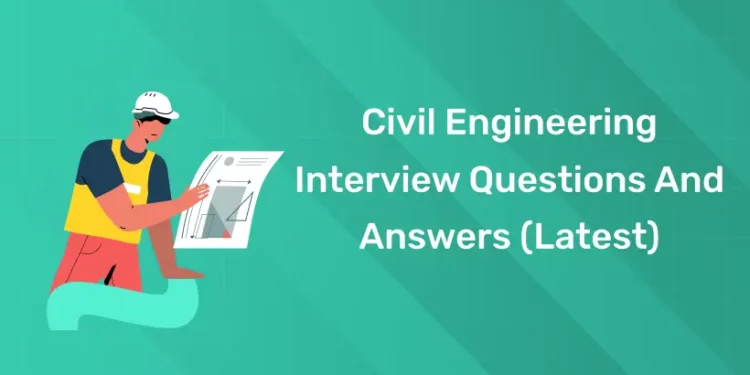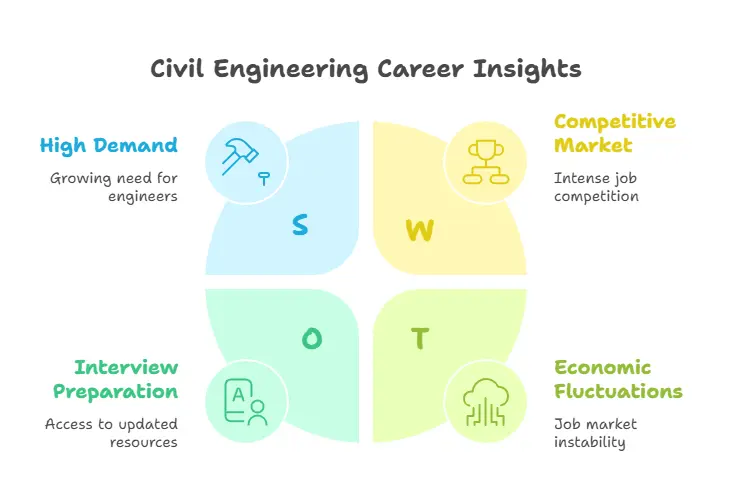Table of Contents
Civil engineering is a venerable and noble field of engineering that has defined the world we inhabit—roads and bridges to dams and skyscrapers. With an increasing need for experienced civil engineers, so increases competition for the best paying job opportunities available in the profession. Whether you are a fresh graduate or an experienced veteran, it is essential that you ready yourself for interviews with confidence. In this blog, we have given the latest civil engineering interview questions and answers (revised for 2025) to assist you in making an impression and getting your dream job.
Get hands-on with our Quantity Surveyor course – sign up for a free demo!
Civil Engineering Interview Questions and Answers
Q: What is the difference between QA and QC in construction?
QA (Quality Assurance) is the preventive process that focuses on how to avoid defects and QC(Quality Control) focuses on how to find and fix defects on the final product.
Q: What is the difference between RCC and PCC?
RCC is reinforced cement concrete that contains steel bars for added tensile strength.
PCC is plain cement concrete that contains only cement, sand and aggregate.
Q: What is the curing process in concrete?
It is a process to maintain moisture in concrete and ensure proper hydration and gain strength after the placement of concrete.
Q: What are the common causes of foundation failure?
Unequal settlement of soil, Poor soil bearing capacity, Inadequate design, Water table fluctuations, Improper construction techniques.
Q: What is a cantilever beam?
It is a beam fixed at one end and freed at the other end and carries load without any external support.
Q: What is a slump test?
It is a test to check the workability of a concrete.
Q: What is BBS (Bar Bending Schedule)?
It is a tabular schedule that gives the details of size, shape and length of the steel bars used.
Q: What is compaction factor test?
It is a lab test to check the workability of concrete especially for the low workability mixes.
Q: What is the function of a shear wall?
It is a wall that helps to resist the lateral forces like wind, earthquake in tall buildings and provides rigidity.
Q: What is bleeding in concrete?
It is a crack that weakens the surface of the concrete when excess water rises to the surface of freshly placed concrete.
Q: What is grouting?
It is a process to inject fluid on to the soil or rock to enhance the strength or reduce permeability.
Q: What are the common types of loads in buildings?
Dead load, Live load, wind load and earthquake load.
Q: What is segregation in concrete?
It’s the separation of coarse aggregate from the mix due to improper handling, leading to weak spots.
Q: What is the difference between one-way and two-way slab?
One way slab is used to carry load in one direction (longer span ≥ 2 × shorter span) and two way slab is used to carry load in both directions (span ratio < 2).
Q: What is the minimum curing period for concrete?
Normally it takes 7 days for OPC and 10 to 14 days for blended cement. For better strength 28 days is ideal for curing.
Q: What is bearing capacity of soil?
It is the maximum load per unit area which the soil can bear without failure.It is measured in: kN/m² or ton/m².
Q: What is the use of a plinth beam?
It is a horizontal beam located at ground floor level to prevent differential settlement and distribute load evenly.
Q: What is meant by camber in road construction?
It is a slight slopes given to the roads to drain water off the surface.
Start a rewarding career in Quantity Surveying! Book for Free Demo Classes Here!
Q: What are the latest trends in Civil Engineering?
Use of sustainable materials (e.g., green concrete, recycled plastic bricks), BIM (Building Information Modeling) Precast and modular construction ,Use of drones and AI for surveying and monitoring 3D concrete printing.
Q: Why did you choose civil engineering as your career?
I have always been interested in how infrastructure influences our daily lives. Civil engineering allows me to balance creativity and logic to design functional and sustainable structures.
Q: What would you do if your project is delayed due to unforeseen weather conditions?
I would inform the stakeholders immediately, determine the cost and schedule impact, and work with the team to create a mitigation plan—e.g., re-sequence activities or utilize rapid-cure materials where practicable.
Conclusion
1: What is the main purpose of a Bill of Quantities (BoQ)?
Practice interview for civil engineering involves strong exposure to theory and practice. Above-provided questions incorporate the major topics such as structural design, materials, methods of construction, soil mechanics, and project management that give candidates the level of confidence they need to excel at interviews. Remaining updated on trends, codes, and application of computer packages as well imparts the competitive advantage. Whether you are a fresher or an experienced professional, overall preparation and cleanness of fundamentals are your secret to success in the ever-changing world of civil engineering.
Master Quantity Surveying – Build a Rewarding Career Today!
Gain in-demand skills in cost estimation, project budgeting, and contract management with our Quantity Surveying Course. Learn from industry experts and boost your career in construction and infrastructure. Enroll now and take the first step toward success!
Know MoreFrequently Asked Questions
What is the standard size of a brick in India?
190 mm × 90 mm × 90 mm (without plaster).
What is honeycombing in concrete?
Voids in concrete caused by improper compaction, leading to a rough surface.
What is compaction?
Removing air from soil or concrete to increase strength.
What software do civil engineers use?
-
AutoCAD (Drafting)
-
STAAD.Pro, ETABS (Structural Design)
-
Revit (BIM)
-
Primavera, MS Project (Project Scheduling)
What is the purpose of a retaining wall?
To hold back soil or water on sloped terrains.
What is a pile foundation?
A deep foundation system used when the topsoil is weak and cannot support the structure’s load.
























